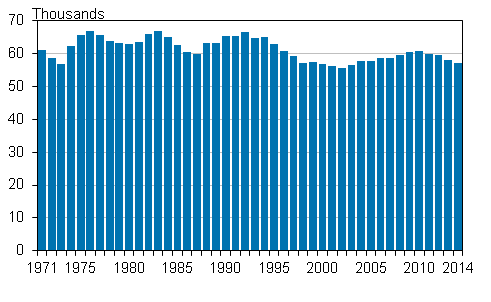Published: 14 April 2015
Number of births continued declining
According to Statistics Finland's data on population changes, the number of births decreased from the year before but the drop was, however, smaller than in the previous year. In 2014, altogether 57,232 children were born, which was 902 fewer than in the year before. Last time the number of births was lower in 2003, when 56,630 children were born. The number of births has now decreased for the fourth year in succession.
Live births 1971–2014

At the fertility rate prevailing in 2014, a woman gives birth to an average of 1.71 children, according to the 2013 fertility rate the number was 1.75 children. At the fertility rate prevailing in 2010, a woman would have given birth to an average of 1.87 children. Since 1969, the birth rate has been below the threshold on population's renewal, which is 2.1 children per woman.
The main reasons for decreasing births over the past four years seem to be connected to having a first and second child. One-half of the decrease in births is explained by the fact that in 2014, the number of first children born was clearly lower than in 2010. One-third of the drop is explained by the number of second children being born also being lower than before.
Last year, women who gave birth to their first child were on average 28.6 years of age. The average age remained unchanged from 2013 but over the past four years it has, however, risen by three decimals. Correspondingly, the average age of all women that gave birth increased by one decimal from the year before to 30.5, but over the past four years it has risen by four decimals.
Birth rate lowest in 41 years in Lapland
Measured with the total fertility rate, the birth rate in the region of Lapland declined from 1.92 to 1.73 children per woman. The rate has last been lower than this in 1973, when it was 1.72. The birth rate of the entire country had also reached a trough at that time as the continuous drop that began in the late 1940s came to an end. At the fertility rate prevailing in 1973, a woman would have given birth to an average of 1.50 children.
The birth rate was above the rate for the whole country in 12 regions. At the 2014 fertility rate, most children would be born in the regions of Ostrobothnia and Kainuu just like in the year before: On average, 2.32 children per woman in Central Ostrobothnia, 2.17 in North Ostrobothnia, 2.01 in South Ostrobothnia, and 1.99 in Kainuu. The birth rate exceeded the threshold on population's renewal only in the two first mentioned regions. The lowest average birth rate of 1.55 would be recorded in the region of Uusimaa.
Birth rate highest in Oulu and lowest in Helsinki
In municipalities with at least 50,000 inhabitants, the highest birth rate was in Oulu, where the total fertility rate was 1.99 in the five year period of 2010 to 2014. The second highest rate was found in Seinäjoki, 1.97 and the third highest in Espoo, 1.91.
Respectively, the birth rate was lowest in Helsinki, where the total fertility rate was 1.34. The rate was 1.37 in Turku and 1.48 in Tampere. Also in a comparison of the whole country the birth rate in the last mentioned municipalities was among the lowest.
Number of live births, total fertility rate and mother's mean age by live births in 2005–2014
| Year | 2005 | 2006 | 2007 | 2008 | 2009 | 2010 | 2011 | 2012 | 2013 | 2014 |
| Number of live births | 57 745 | 58 840 | 58 729 | 59 530 | 60 430 | 60 980 | 59 961 | 59 493 | 58 134 | 57 232 |
| Total fertility rate | 1,80 | 1,84 | 1,83 | 1,85 | 1,86 | 1,87 | 1,83 | 1,80 | 1,75 | 1,71 |
| Mother's mean age by all live births | 30,0 | 30,0 | 30,0 | 30,1 | 30,1 | 30,1 | 30,3 | 30,3 | 30,4 | 30,5 |
| Mother's mean age by first live birth | 27,9 | 28,0 | 28,1 | 28,2 | 28,2 | 28,3 | 28,4 | 28,5 | 28,6 | 28,6 |
Source: Population and Justice Statistics. Statistics Finland
Inquiries: Timo Nikander 029 551 3250, vaesto.tilasto@stat.fi
Director in charge: Riitta Harala
Publication in pdf-format (288.8 kB)
- Tables
-
Tables in databases
Pick the data you need into tables, view the data as graphs, or download the data for your use.
Appendix tables
- Figures
- Quality descriptions
-
- Quality description, births 2014 (14.4.2015)
Updated 14.4.2015
Official Statistics of Finland (OSF):
Births [e-publication].
ISSN=1798-2413. 2014. Helsinki: Statistics Finland [referred: 3.1.2025].
Access method: http://www.stat.fi/til/synt/2014/synt_2014_2015-04-14_tie_001_en.html?ad=notify

